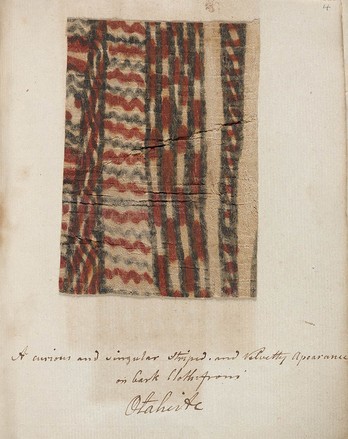Among the rare materials on eighteenth century British exploration of the Pacific ...
By Ania Szafjanska, 2013
Among the rare materials
on eighteenth century British exploration of the Pacific held in the Library is
a bound collection of bark cloth specimens gathered during Captain Cook’s
voyages. Alexander Shaw, a London collector and merchant assembled the
collection in 1787. Having acquired a large number of Cook’s tapa, Shaw cut
them into small pieces to create samplers. The original books were made for
Shaw’s friends, with further copies produced for the wider public.
Tapa cloth is not woven
By Ania Szafjanska, 2013
Tapa cloth is not woven
but made of strips of the inner bark of several types of trees and shrubs,
chiefly mulberry, breadfruit and fig. The bark is dried then soaked, beaten to
form a large sheet, and decorated with paints and vegetable oils. It can be rubbed, stamped, stenciled, smoked or dyed. The designs are specific to particular islands or
areas. As well as practical applications such as bed covers and room dividers, tapa plays an important role in celebrations and rituals.
Shaw’s ‘Tapa Cloth Book’
By Ania Szafjanska, 2013
Due to popular demand,
the Shaw’s ‘Tapa Cloth Book’ was reissued at different times, and the later
volumes, assembled in the early nineteenth century, often contain the original
text alongside new sets of specimens. There are also many post-Shaw
compilations and manuscripts containing tapa samples.
The inner bark is taken from several types of trees or shrubs, often mulberry and fig
By Tapa Cloth, Museum of Natural and Cultural History, University of Oregon
Bark cloth, or tapa, is not a woven material, but
made from bark that has been softened through a process of soaking and beating.
The inner bark is taken from several types of trees or shrubs, often mulberry
and fig, and designs are applied with paints and vegetable dyes of light brown,
red, and black. Bark cloth is manufactured for everyday needs such as room
dividers, clothing, and floor mats, as well as ceremonial uses in weddings and
funerals.



 Back to list
Back to list